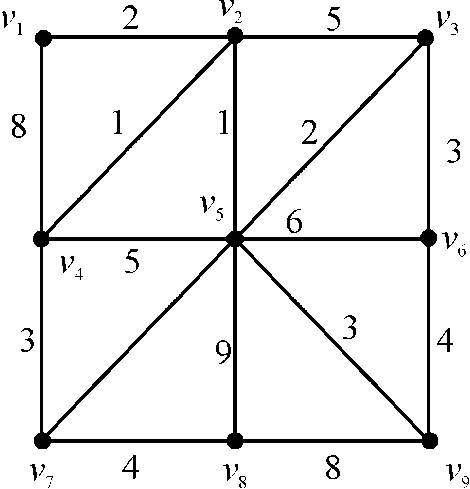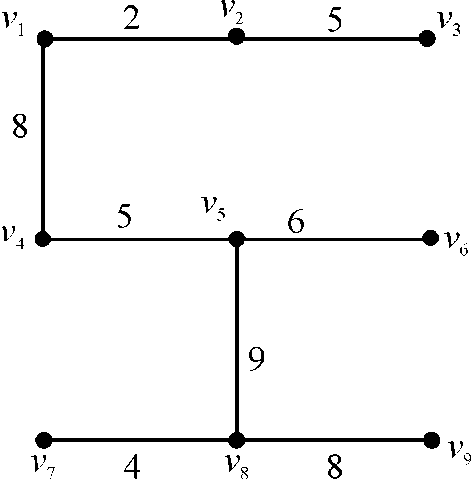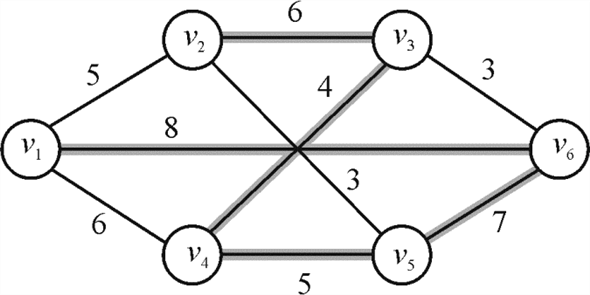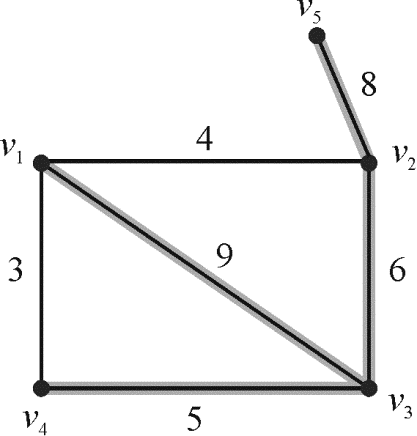Maximum Spanning Tree:
A spanning tree of a connected graph is the tree with minimum number of edges that can cover all the vertices of the graph. That is, it is a tree from which if even one edge is removed, it will become disconnected.
If G is a weighted graph, the maximum spanning tree for that graph will be a spanning tree which will possess maximum total weight. That is, no other spanning tree with weight greater than or equal to maximum spanning tree can be found. The maximum spanning tree can also be called maximum connector in a graph G.
For example: Consider the graph G (V, E) with 9 vertices and 16 edges.

The spanning tree, that is, the tree which connects the vertices of the graph with the edges of maximum weight is as follows:

This tree is called the maximum spanning tree of the graph. The
maximum weight of the spanning tree is  .
.
Each vertex  max
(v) represents the edge with large value of weight.
Mathematically, for an edge
max
(v) represents the edge with large value of weight.
Mathematically, for an edge  , it is
defined as follows:
, it is
defined as follows:

The set  of the
graph is defined as
of the
graph is defined as  . It is the
set of edges of maximum weight. The tree
. It is the
set of edges of maximum weight. The tree  is defined
as the spanning tree of the graph having the maximum value of total
weight.
is defined
as the spanning tree of the graph having the maximum value of total
weight.
a.
Consider the following graph G given below:

The set for the
graph is as follows:
for the
graph is as follows:

The highlighted edges of the graph form the maximum spanning
tree for the
graph. The edges in the spanning tree are given below:
for the
graph. The edges in the spanning tree are given below:

In the above graph, the total weight for the set is  .
.
Hence, the above graph is an example that satisfies the
condition,  .
.
To show  , consider
the graph below in which the dark edges show the maximum spanning
tree of the graph.
, consider
the graph below in which the dark edges show the maximum spanning
tree of the graph.

For the above graph,  .
.
The total weight of the graph is .
.
The edge set for the maximum spanning tree is  and the
total weight is
and the
total weight is  .
.
Hence, the above graph is an example that satisfies the
condition  .
.
c.
Consider a graph G to prove that  . Here,
. Here,
 is
the set of maximum weight edges incident on each vertex and
is
the set of maximum weight edges incident on each vertex and
 is
the maximum spanning tree of
is
the maximum spanning tree of .
.
It is known that for a graph G, whatever maximum spanning tree would be found, it will include the maximum weight edges (by the actual definition of a maximum spanning tree).
In the set , the edges
with maximum weights are incident on each vertex and eventually
each of these edges is already contained in the maximum spanning
tree.
, the edges
with maximum weights are incident on each vertex and eventually
each of these edges is already contained in the maximum spanning
tree.
Therefore,  as
as  would be a subset of
would be a subset of  .
.
d.
To show that , it is
enough to show that weight of maximum spanning tree will be greater
than maximum weight of incident on each vertex.
, it is
enough to show that weight of maximum spanning tree will be greater
than maximum weight of incident on each vertex.
As seen in the above part,  ,
,  would occupy
would occupy
 with the
respective weights.
with the
respective weights.
The weights would have
more weights as they have the edges which form the maximum spanning
tree. If the given condition
would have
more weights as they have the edges which form the maximum spanning
tree. If the given condition  does not
follow, it would not form a spanning tree.
does not
follow, it would not form a spanning tree.
Therefore,  for
any graph G .
for
any graph G .
e.
The following is the 2-approximation algorithm to the maximum spanning tree:
2-APPROXIMATION ALGORITHM
1 Sort the edges of  in
decreasing order on the basis of weight.
in
decreasing order on the basis of weight.
Assume that  is the set
of edges which consist of the maximum spanning tree.
is the set
of edges which consist of the maximum spanning tree.
Initiate .
.
2 Add the first edge to  .
.
3 Now, add the next edge to  only if it
does not form a cycle in
only if it
does not form a cycle in .
.
4 If no edges are left anymore, exit and conclude graph
 as
a disconnected graph.
as
a disconnected graph.
5 If  has
has
 edges
(here, n is the total number of vertices in
edges
(here, n is the total number of vertices in )
)
Output .
.
else go to step 3.
The above algorithm selects the subsequent vertices and the
edges imposed on them will take time  .
.
Therefore, 2-APPROXIMATION ALGORITHM is the required
algorithm that computes a 2-approximation to the maximum spanning
tree with running time  .
.
The knapsack problem is the problem in which the selection of items for filling a knapsack of some definite capacity is done. The items are selected in such a way that they have the weight less than the capacity of knapsack but the value must be as good as possible.
1-1 knapsack problem and fractional knapsack problem:
The 0-1 knapsack problem is the problem which hinders the number of copies of every type of item to either zero or one.
Numerically, the formulation of the 0-1 knapsack problem can be done as:
Assume that there are  items
items . A
non-negative value
. A
non-negative value  and
weight
and
weight is
associated with each item
is
associated with each item .
.
Now the aim of the problem is to make the value  of items as
large as it can be done. Each value tends to a weight such that it
must be less than the capacity of the knapsack as:
of items as
large as it can be done. Each value tends to a weight such that it
must be less than the capacity of the knapsack as:
 and
and .
.
The fractional knapsack problem is the one in which the fractions of the items can be taken for the filling of knapsack. The value and weight of the knapsack are considered for that one fraction of the item.
a.
In 0-1 knapsack problem of , instance
I is the set of n item in which each item j
has profit
, instance
I is the set of n item in which each item j
has profit  and weight
and weight
 for all value of
for all value of .
.
The transformation actually changes in very hard instance of the 0-1 knapsack problem.

Where,  .
.
From above equation it is clear that optimal solution only select those items which capacity is maximum.
Hence, the optimal solution to instance of 0-1 knapsack is
one of  .
.
b.
To show that finding an optimal solution  to the
fractional problem for instance
to the
fractional problem for instance  by including
item
by including
item 
• The optimal solution  can be
constructed to the fractional problem for instance
can be
constructed to the fractional problem for instance  by
including item
by
including item . This would
be possible if item is chosen in the set
. This would
be possible if item is chosen in the set  with the
given maximum values.
with the
given maximum values.
• As it is known that 0-1 knapsack problem gives output 0 or 1 with maximum value.
• The item chosen should be in the order of increasing weight
obtaining optimal solution 
c.
Consider the following procedure to construct an optimal solution.
Finding an optimal solution  to the
fractional problem for instance
to the
fractional problem for instance  by including
the entire item or none of the item in the 0-1 knapsack problem
because if one item is inserted then no item can be removed later
in instance
by including
the entire item or none of the item in the 0-1 knapsack problem
because if one item is inserted then no item can be removed later
in instance  and the
knapsack problem would not succeed.
and the
knapsack problem would not succeed.
Hence user can always construct the optimal solution
 to
the fractional problem.
to
the fractional problem.
d.
If an optimal solution  is obtained
to the fractional problem for instance
is obtained
to the fractional problem for instance by deleting
the fractional item from
by deleting
the fractional item from for this
break a subsequent bag of item as
for this
break a subsequent bag of item as  , it would
always be greater than
, it would
always be greater than  because it
is the optimal solution which consist of selected items and
because it
is the optimal solution which consist of selected items and
 would
consist of the overall item in the bag.
would
consist of the overall item in the bag.
Hence it is clear that:

e.
Randomized approximation algorithms are used for the generation
of approximate solutions for the optimization problems. The
algorithm for the 0-1 knapsack problem is as which returns the
solution with maximum value instance from the solution set
 of
instances
of
instances .
.
2-Approximation algorithm for 0-1 knapsack:
// for loop running for w times.
1. for
// initialize first row of the array with value 0 for each value of w.
2. 
// execute the loop starting from 1 to n
3. for
// initializing the first column of array with value zero for each value of i.

// for loop running for n times.
5. for 
// for loop running for w times.
6. for
// check the condition if ith instance of weight is less than the weight w
7. if
//if statement is used to check the value
8. if
// assign the value to the array cell

9. else
// set the value in the array cell
10. 
11. else
// set the array position with the value
12. 
13. return B
Analysis of Algorithm:
• In the above algorithm initially first row and first column values are set to zero for each value of w and n respectively in the lines 1 to 4.
• The cascaded loops in line 5 and 6 of algorithm are for the filling of 2-dimensional array representing the knapsack with the instances of items.
• The “for” loop in line 1 takes and “for”
loop in line 3 takes time
and “for”
loop in line 3 takes time . The
cascaded “for” loops in line 5 and 6 are taking time
. The
cascaded “for” loops in line 5 and 6 are taking time .
.
So the total time taken by the algorithm is .
.
On ignoring shorter level terms the above algorithm would take
the time  which is the
polynomial time.
which is the
polynomial time.
Hence, the above 2-approximate knapsack problem is polynomial time algorithm.































